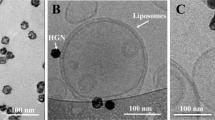Abstract
This paper describes the optochemical pH and oxygen sensing properties of dye-encapsulating and fluorescently labeled nano-sized unilamellar liposomes. To prepare the oxygen sensitive liposomes a lipid mixture consisting of dimyristoylphospatidylcholine, cholesterol, and dihexadecyl phosphate (molar ratio 5:4:1) all dissolved in dry isopropyl alcohol is injected into a sensing dye solution. The mixture is then sonicated with a liposome maker to form dye-encapsulating liposomes. A lipid mixture consisting of dimyristoylphospatidylcholine, N-(fluorescein-5-thiocarbamoyl)-1,2-dihexadecanoyl-sn-glycero-3-phosphoethanolamine triethylammonium salt (fluorescein DHPE), cholesterol, and dihexadecyl phosphate (molar ratio 20:1:16:4) is used to prepare the pH sensitive liposomes by the same sonication technique. Fluorescein labeled DHPE phospholipids are combined with DMPC phospholipids in a 1:20 ratio to incorporate the sensing dye directly into the bilayer membrane, virtually eliminating any instability due to dye leakage. Oxygen sensing liposomes are created by encapsulating the oxygen sensitive ruthenium tris(1,10)-phenanthroline complex [Ru(phen)3]. The dye is believed to exist both in free solution within the liposome, and as an adherent on the inner membrane of the liposome. High uniformity of the liposomes is realized by extruding them back and forth through a 100 nm pore-size polycarbonate membrane. TEM images of the liposomes, stained with uranyl acetate, show that the liposomes are unilamellar, spherical in shape, maintain high structural integrity, and average 70 nm in diameter. The liposomes show high stability with respect to dye leaking at room temperature for 8 days, and high photostability when exposed to the excitation light. Individual liposomes are used to monitor the pH and oxygen level in their vicinity during the enzymatic oxidation of glucose by the enzyme glucose oxidase. The newly prepared environmentally sensitive liposomes can be applied for non-invasive pH and oxygen determination in tissues and single biological cells.
Similar content being viewed by others
Author information
Authors and Affiliations
Additional information
Received June 8, 1998. Revision November 10, 1998.
Rights and permissions
About this article
Cite this article
McNamara, K., Rosenzweig, N. & Rosenzweig, Z. Liposome-Based Optochemical Nanosensors. Mikrochim Acta 131, 57–64 (1999). https://doi.org/10.1007/s006040050009
Issue Date:
DOI: https://doi.org/10.1007/s006040050009




